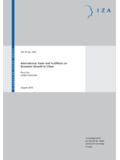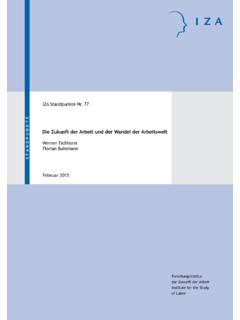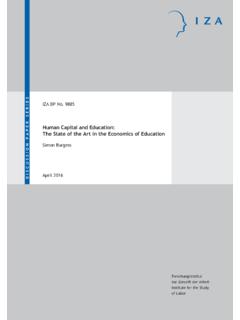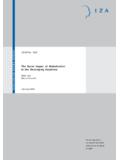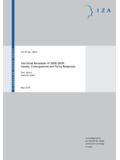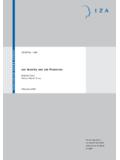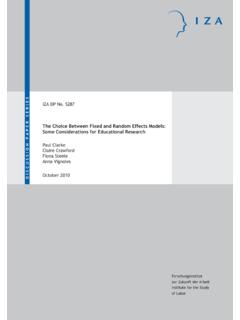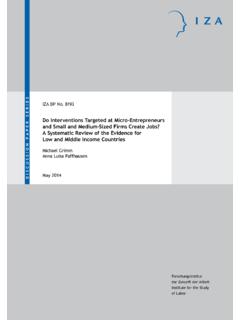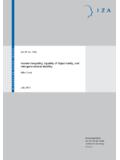Transcription of Workplace Performance, Worker Commitment and Loyalty
1 DISCUSSION PAPER SERIESF orschungsinstitut zur Zukunft der ArbeitInstitute for the Study of Labor Workplace performance , Worker Commitment and LoyaltyIZA DP No. 5447 January 2011 Sarah BrownJolian McHardyRobert McNabbKarl Taylor Workplace performance , Worker Commitment and Loyalty Sarah Brown University of Sheffield and IZA Jolian McHardy University of Sheffield Robert McNabb Cardiff University Karl Taylor University of Sheffield and IZA Discussion Paper No. 5447 January 2011 IZA Box 7240 53072 Bonn Germany Phone: +49-228-3894-0 Fax: +49-228-3894-180 E-mail: Any opinions expressed here are those of the author(s) and not those of IZA. Research published in this series may include views on policy, but the institute itself takes no institutional policy positions. The Institute for the Study of Labor (IZA) in Bonn is a local and virtual international research center and a place of communication between science, politics and business.
2 IZA is an independent nonprofit organization supported by Deutsche Post Foundation. The center is associated with the University of Bonn and offers a stimulating research environment through its international network, workshops and conferences, data service, project support, research visits and doctoral program. IZA engages in (i) original and internationally competitive research in all fields of labor economics, (ii) development of policy concepts, and (iii) dissemination of research results and concepts to the interested public. IZA Discussion Papers often represent preliminary work and are circulated to encourage discussion. Citation of such a paper should account for its provisional character. A revised version may be available directly from the author. IZA Discussion Paper No. 5447 January 2011 ABSTRACT Workplace performance , Worker Commitment and Loyalty * Using matched employer-employee level data drawn from the 2004 UK Workplace and Employee Relations Survey, we explore the determinants of a measure of Worker Commitment and Loyalty (CLI) and whether CLI influences Workplace performance .
3 Factors influencing employee Commitment and Loyalty include age and gender, whilst Workplace level characteristics of importance include human resource practices. With respect to the effects of employee Commitment and Loyalty upon the Workplace , higher CLI is associated with enhanced Workplace performance . Our findings that Workplace human resources influence CLI suggest that employers may be able to exert some influence over the Commitment and Loyalty of its workforce, which, in turn, may affect Workplace performance . JEL Classification: J20, J50 Keywords: Commitment , financial performance , labor productivity, Loyalty Corresponding author: Karl Taylor Department of Economics University of Sheffield 9 Mappin Street Sheffield S1 4DT United Kingdom E-mail: * We are grateful to the Data Archive at the University of Essex for supplying data from the 2004 Workplace and Employee Relations Survey.
4 We are also grateful to the Co-editor, two anonymous referees, as well as Andy Dickerson, Steven McIntosh and Stephen Wood for valuable comments and advice. We are also grateful to participants at the Work and Pensions Economics Group Annual Conference, Nottingham, July 2009, for excellent comments. The normal disclaimer applies. 2 1. Introduction A large empirical literature exists which explores the determinants of organizational performance . For example, Machin and Stewart (1990), McNabb and Whitfield (1998) and Munday et al. (2003) examine the determinants of financial performance , whilst Griliches and Regev (1995), Oulton (1998) and Griffiths and Simpson (2004) focus on the determinants of labor productivity. Many such studies are based on firm level data. One might argue, however, that, in order to understand the determinants of firm performance , it is important to also analyze employee level information given that the behavior of employees and the decisions they make may influence Workplace performance .
5 In this paper, we investigate whether the level of employee attachment to the organization influences Workplace performance using matched employer-employee data. To be specific, we seek to ascertain whether Worker Commitment and Loyalty influence labor productivity and financial performance at the firm level. In addition, we explore the determinants of such employee attitudes towards the organization for which they work in order to establish how such attachments may be fostered. The concept of organizational Commitment has attracted a great deal of interest in the human resource management and psychology literatures. For example, employee Commitment and Loyalty are central features in the high performance Workplace literature in which they are seen as mediating factors linking different types of human resource management and employment practices to enhanced performance . In this paper, we focus on affective Commitment , which, according to Meyer and Allen (1991, ) refers to the.
6 Employee s emotional attachment to, identification with, and involvement in the organization. They continue ( ) Employees with a strong affective Commitment 3 continue employment with the organization because they want to do so. 1 Meyer et al. (1993, 2002) argue that strong affective Commitment to an organization arises because employees share values with both the organization and its members and it is therefore predicted to be positively associated with job performance . Moreover, establishing a committed and loyal workforce may be associated with enhanced firm performance through less opportunistic behavior on the part of employees (Green, 2008) or through influencing their supply of effort, and hence output. Employees decisions over their supply of effort play a key role in various incentive models of Worker compensation (see, for example, Lazear, 2000) as well as in the efficiency wage literature (see Akerlof, 1982 and Akerlof and Yellen, 1990).
7 Given such a relationship between employee effort and Commitment , an interesting line of enquiry concerns how the firm may influence the level of affective Commitment via human resource (HR) practices. Employee Commitment and Loyalty thus arguably play an important role in the principal-agent issues surrounding the separation between the ownership and control of an organization. The costs associated with delegated decision-making clearly depend on the extent to which the interests of the principal and agent differ (see, for example, Aghion and Tirole, 1997, and Athey and Roberts, 2001). In so far as employees who exhibit Commitment and Loyalty towards their employer may have interests which are aligned with those of their employer, the agency costs often associated with the employee-employer relationship are reduced. One attempt to construct an economic model of identity and work incentives, thus capturing such motivations, is Akerlof and Kranton (2005), whose analysis, within a principal-agent framework, suggests that instilling in employees a sense of identity and 1 Meyer and Allen (1991) introduce a three-component model of organizational Commitment .
8 In addition to affective Commitment , according to Meyer et al. (1993, ), employees with a strong continuance Commitment remain [with the organization] because they need to, and those with a strong normative Commitment remain because they feel they ought to do so. Though, in their the review of the Workplace and Employee Relations Survey (WERS) 2004, Bewley et al. (2010) recommend extending the questionnaire in WERS 2011 to include both normative and continuance Commitment , WERS 2004, on which our paper is based, includes only affective Commitment , limiting our study accordingly. 4 attachment to an organization is critical to well-functioning enterprises (op. cit., p. 11). We introduce and apply their framework in our theoretical discussion below. Given that the degree of Commitment and Loyalty of employees towards their employer is fundamentally linked to the way in which employees conduct themselves at the Workplace , as well as the agency considerations that underpin the relationship between employees and employers, it is surprising that employee Commitment and Loyalty have attracted only limited attention in the economics literature.
9 In the following section we outline a theoretical framework to explain the link between HR practices, affective Commitment and Worker and firm performance in the context of the principal-agent problem. In the empirical analysis which then follows, we firstly explore the determinants of affective Commitment at the employee level with the focus on how HR practices influence such Commitment . Secondly, we explore the implications of employee Commitment and Loyalty for financial performance and labor productivity at the firm level, which contrasts with the focus in the management and psychology literatures, which have tended to focus on the relationship between employee Commitment and job performance rather than firm performance . 2. Theoretical Framework In this section we discuss a theoretical rationale for our empirical findings of a positive link between various HR practices and Worker Commitment through to improved firm performance .
10 Our theoretical approach has two parts. We begin by setting out the theoretical channels (supported by empirical evidence) through which HR practices influence affective Commitment . We then demonstrate that the positive link between affective Commitment and firm performance can be explained as a logical prediction of the principal-agent model developed to include affective 2 Though indicating theoretical channels through which HR practices may influence firm performance via Worker Commitment , our discussion is not intended to be exhaustive. 5 Affective Commitment and Loyalty Numerous authors have identified links between HR practices and affective Commitment . Of the various factors recognized as having an influence on affective Commitment , those relevant to the present study (and discussed in more detail below) are organizational communication, raising Commitment through empowerment of the employee ( Stuart, 1999) or though employee participation and involvement ( Cotton et al.)
